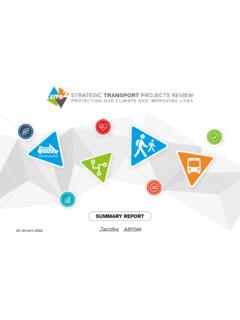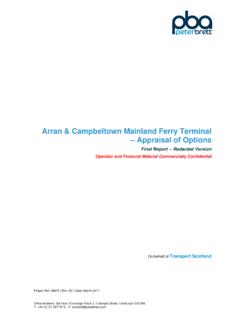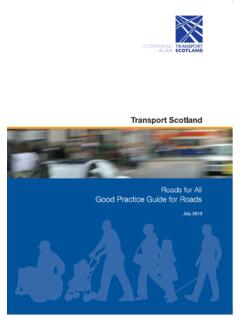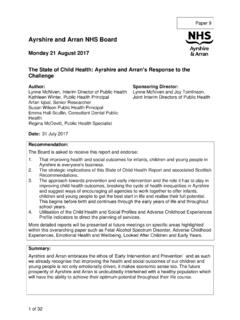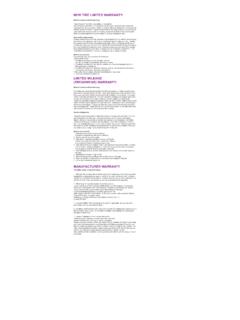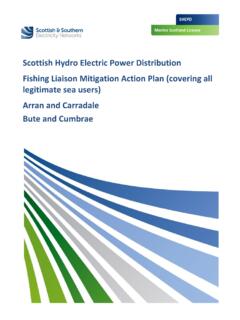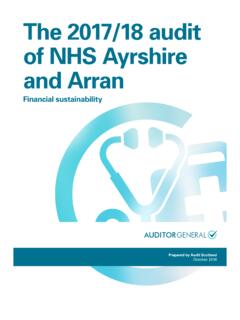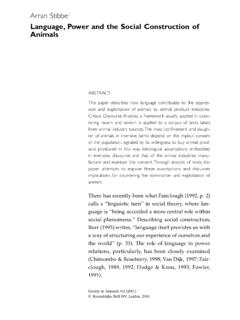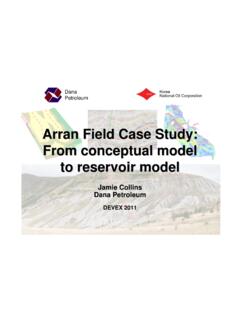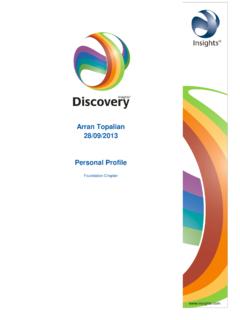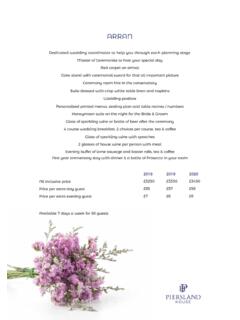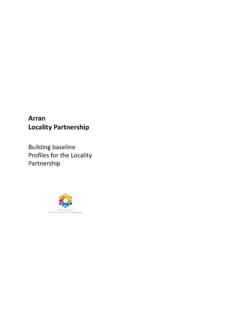Transcription of Evaluation of the impact of Road Equivalent Tariff on Arran
1 ReportEvaluation of the impact of road Equivalent Tariff on ArranEvaluation Of The impact Of road Equivalent Tariff On Arran Transport Scotland 1 Contents Summary 2 1 Introduction 7 2 Research Approach 10 3 Travel Behaviour 11 4 Demand for Ferry Travel & Demand Management 14 5 Tourism in Arran 31 6 The Arran Economy 35 7 Conclusions 48 Evaluation Of The impact Of road Equivalent Tariff On Arran Transport Scotland2 Summary road Equivalent Tariff (RET) involves setting ferry fares on the basis of the cost of travelling an Equivalent distance by road , including a fixed element to keep fares sustainable and cover fixed costs such as infrastructure. In line with the commitment made in the Ferries Plan 2013-2022, RET was introduced on the Arran routes in October 2014. These routes are: the principal route between Ardrossan and Brodick; the summer route between Claonaig and Lochranza; and the winter (and principally freight route) between Tarbert (Loch Fyne) and Lochranza.
2 The objectives of the roll-out of RET to Arran , which were set by Transport Scotland, are: to increase demand for ferry services by making ferry travel more affordable and more accessible; to increase tourism to Arran and support existing tourism markets; and to enhance the local Arran economy and wider national economy. Transport Scotland commissioned Peter Brett Associates LLP, together with Wellside Research, in December 2014 to conduct a two-year Evaluation of the impact of RET on the island of Arran . The Evaluation was informed by a range of primary ( ferry user, household, business and haulier surveys) and secondary ( ferry operator and socio-economic data) research. The key findings are as follows: Scale of Fares Reductions The Ardrossan-Brodick and Claonaig-Lochranza routes both provide ferry services for passengers, cars, commercial vehicles (CVs) and RET fares are in place for passengers, cars (including small CVs under 6 metres in length) and coaches.
3 The table below sets out the change in fares between the published summer 2014 fares and the RET fares introduced for the winter timetable. Table S1: 2014/15 RET Fares & Fare Reductions from Summer 2014 Single Fares Route Passengers Cars Single Fare Summer 2014 RET Fare 2014/15 % Change Single Fare Summer 2014 RET Fare 2014/15 % Change Ardrossan Brodick -46% -64% Claonaig / Tarbert - Lochranza -55% -66% 1 It is worth noting that the winter only Tarbert (Loch Fyne) Lochranza route is principally a freight only route, operated specifically to support the flow of goods classified as dangerous under the International Maritime Dangerous Goods (IMDG) Code. During the winter, the Ardrossan Brodick route is operated by a single vessel, the MV Caledonian Isles. As this vessel is closed deck ( the car deck is sealed), it cannot carry dangerous goods such as hay and fuel unless operated in freight mode ( it runs with a maximum of 12 passengers).
4 The operation of the Tarbert (Loch Fyne) Lochranza route is the solution to this and, as this is mainly a freight only route, the impact of RET is likely to be minimal. Evaluation Of The impact Of road Equivalent Tariff On Arran Transport Scotland 3 Travel behaviour RET has significantly increased resident ferry travel across all journey purposes. The data suggest a degree of novelty in the 2015 resident use ( increased leisure trips) which has not been sustained into 2016. However, there appears to be a gradual evolution in travel behaviour, with the ferry being increasingly used for business and education trips. The observed / outturn price elasticity of demand on the Ardrossan Brodick route is for passengers and for cars. This implies that passenger demand is relatively inelastic in comparisons to vehicle demand, which is far more elastic. On the Claonaig-Lochranza route, the elasticity for both passengers and cars is The reduced fares have acted as a significant stimulus to non-resident use of the ferry, with a step-change in day-trip, short and long-stay tourism.
5 Demand & Capacity Demand for ferry services & demand management measures The total carryings for the last full pre-RET year (2013/14) and the first two years for RET are shown in the table below: Table S2: Arran routes pre and post RET carryings2 Passengers Cars Coaches CVs CV LM 28 October 2013 - 26th October 2014 Ardrossan to Brodick 704,007 131,529 610 11,874 128,433 Claonaig to Lochranza 46,265 14,794 51 385 3,423 TOTAL 2013-14 750,272 146,323 661 12,259 131,856 27th October 2014 25th October 2015 Ardrossan to Brodick 765,031 189,438 551 8,723 99,930 Claonaig to Lochranza 58,699 20,727 47 319 2,930 TOTAL 2014-15 823,730 210,165 598 9,042 102,860 26th October 2015 23rd October 2016 Ardrossan to Brodick 807,732 199,001 628 9,770 113,562 Claonaig to Lochranza 65,908 23,639 66 350 3,226 TOTAL 2015-16 873,640 222,640 694 10,120 116,788 The introduction of RET to the Arran routes has significantly increased the demand for ferry services.
6 This has been particularly noticeable in terms of car carryings where, across the two routes, 76,000 extra cars were carried in 2015/16 compared to the last pre-RET year (2013-14), an increase of 52%. This increase is dominated by the Ardrossan Brodick route (around 67,000 additional cars). 2 Note, the figures in the table have been equated to the RET year rather than the contract year. Evaluation Of The impact Of road Equivalent Tariff On Arran Transport Scotland 4 Passenger carryings have also increased, although the uplift is much more modest when compared to vehicle carryings, at 16%. This suggests that a number of ferry users that previously travelled as foot passengers are now taking a car onboard. This finding is supported by the primary research and suggests that RET has had a very significant impact as a generator of car trips. CV and CV lane metre (LM) carryings have declined, largely due to redefinition of the length at which a vehicle is defined as commercial from five to six metres.
7 In absolute terms, RET has had a larger impact on Arran than on any other island in the Clyde & Hebridean Ferry Services (CHFS) network. Around three quarters of passengers & cars and around two thirds of annual CV carryings on the Ardrossan Brodick route are in the summer months (April-October). This has been broadly consistent pre and post RET. The vast majority of coaches are carried in the summer months. The Ardrossan Brodick route is beginning to experience vehicle deck capacity issues on peak sailings, with 26% of all sailings in 2015/16 having a car deck utilisation of greater than 80%. The introduction of a new vessel on this route in 2018 will largely address these capacity problems. The Claonaig Lochranza has not experienced significant passenger or vehicle capacity problems. The introduction of the new hybrid ferry, MV Catriona, in September 2016 has provided further scope for growth.
8 The current demand management measures, which prohibit over-height vehicles from certain peak sailings, are appropriately targeted at the highest utilisation sailings. Resident perceptions of capacity There is a clear perception of vehicle deck capacity issues amongst Arran residents, with a significant number of residents in both years of the Evaluation reporting at least one occasion where they could not secure a car booking on their preferred sailing. From the perspective of island residents, the perceived vehicle capacity issues were significantly worse in the second year of RET (2015/16) than the first (2014/15). Visitor perceptions of capacity Around one quarter of visitors reported difficulties securing a booking on their preferred sailing on both Arran routes (despite a propensity to book in advance). From a visitor perspective, capacity constrained sailings are generally from Ardrossan and are concentrated around the weekends.
9 On average, just over 10% of visitors using the Ardrossan - Brodick route indicated that they did not travel to Arran on the occasion on which they could not secure a vehicle booking. This implies that the boost in trade for the island provided by RET has been partially constrained by vehicle capacity. Evaluation Of The impact Of road Equivalent Tariff On Arran Transport Scotland 5 Tourism in Arran The research clearly highlighted the hugely positive impact of RET on tourism. The number of tourists coming to the island has increased substantially, whilst the season has been extended from Easter & peak summer to the Equivalent of the whole summer timetable ( Easter to the October school holidays). Across the two summer onboard surveys, 11% of visitors questioned on Ardrossan Brodick and 17% on Claonaig Lochranza noted that their journey had been wholly prompted by RET fares. 11% (on average over the two summer surveys) of visitors would not have visited Scotland without the introduction of RET on the Arran services.
10 This group of visitors represents a much larger proportion of those staying in paid accommodation for more than one night. The introduction of RET has therefore made a positive contribution to the Scottish tourism industry. The introduction of RET to Arran and neighbouring islands / peninsulas has enhanced the island / peninsula-hopping tourism market. impact on the Arran economy Aggregate impact Arran businesses were highly positive about the impact of RET, with the majority citing increases in both footfall and turnover. The evidence clearly demonstrates that the largest benefit has accrued to the tourism sector, with hotels, campsites, guesthouses, golf courses, visitor attractions etc all highlighting the particularly positive impact of RET. A number of retail businesses exposed to mainland competition did however explain that their customer numbers and turnover have declined. There was a widely expressed view amongst businesses that RET has been particularly beneficial to the more remote areas of Arran , particularly on the west coast.
